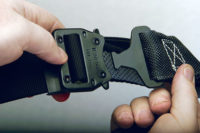It’s the same thing year after year after year. For anyone in the fall protection industry it’s frustrating and maddening. I look up to see that injuries and deaths from falls are among the highest among reported accidents in the U.S. workplace. At the same time OSHA continues to report more violations of the general requirements for fall protection than almost any other standard.
It appears that the American worker prefers to risk his life than pay attention to some simple procedures. I don’t believe ignorance of the high risk is the problem. Most of these workers have been issued appropriate equipment and have been trained to use it.
Why do I even care? Well I spend my life designing and building fall protection equipment. In addition I spend countless hours talking to workers and employers alike training them to be careful, hopefully to be “safe,” and so when I read these same results time after time, I get angry and frustrated, to say nothing of disappointed.
Here are four steps you can take to avoid your own fall protection frustrations:
Harness system inspection procedures
General
1. Check for wear and deterioration. Before each use, carefully inspect your harness for signs of wear, deterioration, or evidence of impact loading. Visually inspect for loose threads, pulled rivets, burns, cuts, distortions, abrasions, or any other evidence of chemical or physical deterioration that may have weakened the material or assembly.
2. Inspect hardware for malfunctions and cracks. Check all snap hooks, buckles and D-rings.
3. Remove from service and replace all worn or damaged equipment. If any part does not pass inspection, immediately remove the harness from service and destroy.
Note the “key words” – before each use.
Specific
1. Stitching and webbing. Check stitching for broken, burned, cut or pulled stitches. Broken strands appear as tufts on the surface. To inspect, hold the webbing with your hands six to eight inches apart. Bend the webbing in an inverted U to cause surface tension, exposing problem areas. Inspect all web areas. Damage from cuts, abrasion, corrosives, heat or chemicals should be apparent.
2. Buckles and belt ends. Inspect the ends of all straps. They are subject to wear as a result of repeated opening and closing. Enlargement or distortion of holes may indicate excessive wear or possible damage through impact loading. Harnesses with unusually enlarged or distorted holes fail inspection.
3. D-rings. All D-rings should be checked for distortion. D-ring attachment points should be checked for unusual wear or damaged fibers. Badly pitted D-rings indicate chemical corrosion, and the equipment failed inspection.
4. Stitching or rivets at hardware attachment points. For stitched attachment points, check that stitching is not broken, burned, cut or pulled. Check all riveted attachment points for tightness. Badly pitted rivets indicate chemical corrosion, and the equipment should fail inspection.
5. Tongue buckles. All tongue buckles should be checked for distortion, sharp edges and cracks. The tongue should move freely and overlap the frame. Rollers should not be distorted and should roll freely.
6. Friction slide adjusters. Friction slide adjusters should be checked for sharp edges, distortion. Make sure that the outer bars and center bars are straight. Also check corners and attachment points for wear and cracks.
7. Easy-connect buckle. Easy-connect buckle (square rings) should be checked for distortion, sharp edges and cracks. For stitched attachment points, check that stitching is not broken, burned, cut or pulled.
8. Friction-style buckle. Friction-style buckles should be checked for sharp edges, cracks and distortion. Make sure outer bars and center bar are straight. Also check corners and attachment points for wear. Is this reading bordering on boring and tedious? Think about a lifetime in a wheelchair. That’s tedium.
Destroy or replace worn or damaged harnesses
If evidence of excessive wear, deterioration or mechanical malefaction is observed; the harness should be destroyed. Never work with worn or damaged equipment. Using damaged or worn equipment can cause serious injury or death.
No shortcuts
The inspector is the most important part of any inspection procedure. That’s you. Check all equipment thoroughly and follow all safety procedures and guidelines. Don’t take any shortcuts.
Important note: OSHA specifies that all employers covered by the Occupational Safety and Health Act are responsible for inspection and maintenance of all tools and equipment used by employees, whether owned by the employees or by the company. All Ultra-Safe equipment should be inspected before each use, and immediately removed from service if equipment does not pass inspection.
When inspecting web-style retractables or deceleration units, check the stitching for broken, burned, cut or pulled stitches, and the breakaway jacket for cuts, tears, broken stitches, stretch marks or other evidence of impact load. For cable lanyards, check the full length for breaks, burns or cuts in the vinyl covering and the cable.
Check for broken strands. Inspect rope lanyards for broken strands by twisting the rope slightly to undo the braiding. Inspect the entire lanyard in this manner. Lanyards with broken strands must be discarded.
Inspect all snap hooks, D-Rings and other metal parts. Hardware must be checked for sharp edges and cracks. Rollers should not be distorted in shape and should roll freely. Check all parts, especially corners and attachments points, for wear and cracks.
Inspecting self-retracting devices
As per SRLS – ANSI 359-14-2012, the frequency of inspection by a competent person, and factory authorized inspections, is determined by usage. As the user, you must conduct an eight-point inspection of your self-retracting device (SRD) before each use.
1. Ensure the safety retractable locks when the lifeline is pulled sharply, with no slippage. Lock-up should be positive.
2. Labels must be present and fully legible.
3. Check the connecting hooks or carabiners for damage, distortion or corrosion, and working condition.
4. Check the housing for distortion, cracks or other damage and make sure anchorage point is not distorted or damaged.
5. Inspect each component of the personal fail protection system according to the manufacturer’s instructions.
6. The lifeline must fully extend and retract smoothly with no hesitation or slack on the line.
7. Check the lifeline for cuts, burns, chemical damage, abrasions, loose strands or corrosion; the lifeline must not be damaged.
8. Check for loose or missing screws and bent or damaged parts.



